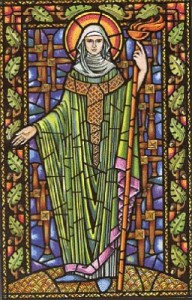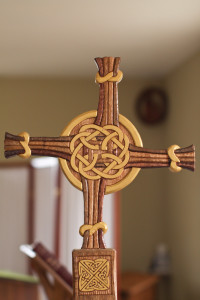 Who in the world was St. Brigit?
Who in the world was St. Brigit?
St. Brigit was a Celtic nun who lived in Ireland from 453 to 524 A.D. In addition to being a nun, she was an abbess and founded several monasteries. She was known for having a heart wide open to the needs of the poor which was one of the reasons we chose her as our patron saint. And, as with any good saint, there are lots of stories surrounding her life. One of our favorites happens to be how she turned her bathwater into beer to provide hospitality to some traveling clergymen (we think that’s pretty cool). The way in which St. Brigit followed Christ inspires and guides us in our life together.
BRIGID OF KILDARE, Monastic, c. 523
OGod, whose servant Brigid, kindled with the flame of your love, became a shining light in your church: Grant that we also may be aflame with the spirit of love and discipline, and walk before you as children of light; through Jesus Christ our Lord, who lives and reigns with you, in the unity of the Holy Spirit, one God, now and for ever. Amen.
Along with Patrick, Brigid is one of the most beloved Irish saints. She was born into slavery in the middle of the fifth century, the daughter of a local chieftain and one of his slaves. Her father Dubhthach was the poet laureate of King Loeghaire and a pagan, but her mother Brocca was a Christian.
Even as a young girl, Brigid was notorious for giving away all of the family’s food and goods in order to feed and assist the poor. Enraged, her father tried to sell her to the king of Leinster, but even while the two men were negotiating her price, she took her father’s jeweled sword and gave it to a beggar so that he could sell it to feed his family. The king was impressed with her compassion and resourcefulness, and offered Dubhthach his own jeweled sword as a replacement, telling him to give his daughter her freedom.
Gathering a group of women around her, Brigid founded a monastery in 470 at Kildare, a place whose name meant “Church of the Oak.” This was the first monastic community for women in Ireland. Tosecure the sacraments, Brigid persuaded the anchorite Conlaed to receive ordination as a bishop and to bring his community of monks to Kildare, thus establishing a double monastery for both men and women. She also founded a renowned scriptorium and center for manuscript illumination at the monastic community.
Brigid actively participated in leadership and in policy-making decisions, not only within her own monastic federation but also within the councils and synods of the Irish church. She died around 523 at Kildare. Her remains are said to have been re-interred with those of Patrick at Downpatrick in the ninth century.
This is a photograph of our processional cross carved by a local woodworker. There are many versions of the legend of St. Brigit’s Cross. One version goes as follows:
A pagan chieftain from the neighbourhood of Kildare was dying. Christians in his household sent for Brigit to talk to him about Christ. When she arrived, the chieftain was raving. As it was impossible to instruct this delirious man, hopes for his conversion seemed doubtful. Brigit sat down at his bedside and began consoling him. As was customary, the dirt floor was strewn with rushes both for warmth and cleanliness. Brigit stooped down and started to weave them into a cross, fastening the points together. The sick man asked what she was doing. She began to explain the cross, and as she talked, his delirium quieted and he questioned her with growing interest. Through her weaving, he converted and was baptized at the point of death. Since then, the cross of rushes has existed in Ireland.

 St. Brigit’s Cross
St. Brigit’s Cross